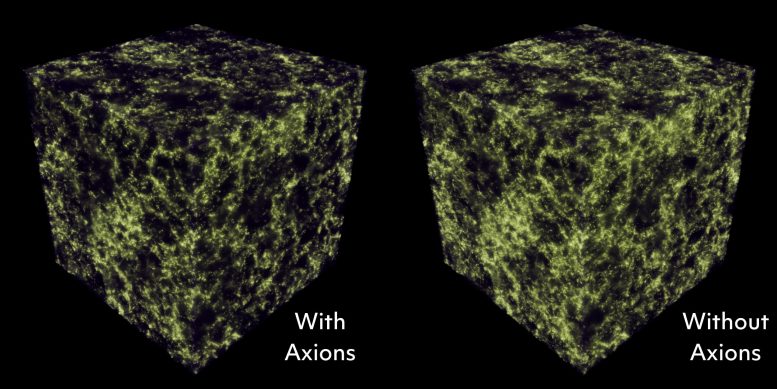
A computer simulation of a section of the universe with and without axions showing how the dark matter cosmic web structure is less clumpy if containing axions. For scale, the Milky Way galaxy would sit inside one of the small green dots that are called halos. Credit: Alexander Spencer London/Alex Laguë.
Researchers propose in a new study that the universe’s lack of clumpiness suggests dark matter is composed of hypothetical, ultra-light particles called axions. If confirmed, this could have broad implications for our understanding of the universe and could even provide support for string theory.
In a study published on June 14 in the Journal of Cosmology and Astroparticle Physics, researchers at the University of Toronto reveal a theoretical breakthrough that may explain both the nature of invisible dark matter and the large-scale structure of the universe known as the cosmic web. The result establishes a new link between these two longstanding problems in astronomy, opening new possibilities for understanding the cosmos.
The research suggests that the “clumpiness problem,” which centers on the unexpectedly even distribution of matter on large scales throughout the cosmos, may be a sign that dark matter is composed of hypothetical, ultra-light particles called axions. The implications of proving the existence of hard-to-detect axions extend beyond understanding dark matter and could address fundamental questions about the nature of the universe itself.
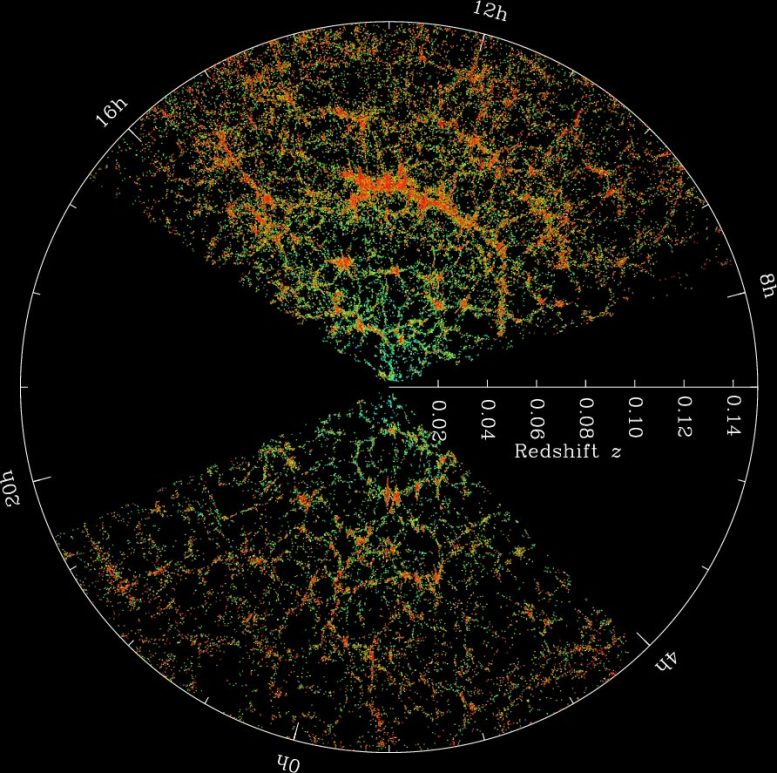
A map of galaxies in the local universe as seen by the Sloan Digital Sky Survey which the researchers used to test the axion theory. Each dot is the position of a galaxy and the Earth sits in the middle of the map. Credit: Sloan Digital Sky Survey
“If confirmed with future telescope observations and lab experiments, finding axion dark matter would be one of the most significant discoveries of this century,” says lead author Keir Rogers, Dunlap Fellow at the Dunlap Institute for Astronomy & Astrophysics in the Faculty of Arts & Science at the University of Toronto. “At the same time, our results suggest an explanation for why the universe is less clumpy than we thought, an observation that has become increasingly clear over the last decade or so, and currently leaves our theory of the universe uncertain.”
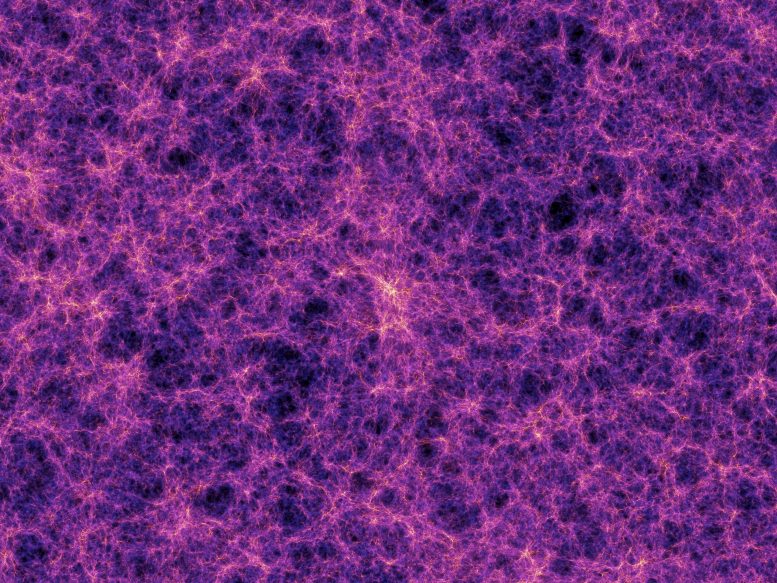
In shaping the universe, gravity builds a vast cobweb-like structure of filaments tying galaxies and clusters of galaxies together along invisible bridges hundreds of millions of light-years long. This is known as the cosmic web. Credit: Volker Springel (Max Planck Institute for Astrophysics) et al.
Dark matter, comprising 85 percent of the universe’s mass, is invisible because it does not interact with light. Scientists study its gravitational effects on visible matter to understand how it is distributed in the universe.
A leading theory proposes that dark matter is made of axions, described in quantum mechanics as “fuzzy” due to their wave-like behavior. Unlike discrete point-like particles, axions can have wavelengths larger than entire galaxies. This fuzziness influences the formation and distribution of dark matter, potentially explaining why the universe is less clumpy than predicted in a universe without axions.
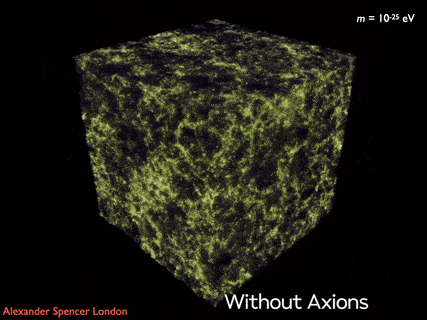
A computer simulation of a section of the universe with and without axions showing how the dark matter cosmic web structure is less clumpy if containing axions. For scale, the Milky Way galaxy would sit inside one of the small green dots that are called halos. Credit: Alexander Spencer London/Alex Laguë
This lack of clumpiness has been observed in large galaxy surveys, challenging the other prevailing theory that dark matter consists only of heavy, weakly interacting sub-atomic particles called WIMPs. Despite experiments like the Large Hadron Collider, no evidence supporting the existence of WIMPs has been found.

Keir Rogers, lead author of the study and Dunlap Fellow at the Dunlap Institute for Astronomy & Astrophysics. Credit: Courtesy Keir Rogers
“In science, it’s when ideas break down that new discoveries are made and age-old problems are solved,” says Rogers.
For the study, the research team — led by Rogers and including members of associate professor Renée Hložek’s research group at the Dunlap Institute, as well as from the University of Pennsylvania, Institute for Advanced Study, Columbia University and King’s College London — analyzed observations of relic light from the Big Bang, known as the Cosmic Microwave Background (CMB), obtained from the Planck 2018, Atacama Cosmology Telescope and South Pole Telescope surveys. The researchers compared these CMB data with galaxy clustering data from the Baryon Oscillation Spectroscopic Survey (BOSS), which maps the positions of approximately a million galaxies in the nearby universe. By studying the distribution of galaxies, which mirrors the behavior of dark matter under gravitational forces, they measured fluctuations in the amount of matter throughout the universe and confirmed its reduced clumpiness compared to predictions.
The researchers then conducted computer simulations to predict the appearance of relic light and the distribution of galaxies in a universe with long dark matter waves. These calculations aligned with CMB data from the Big Bang and galaxy clustering data, supporting the notion that fuzzy axions could account for the clumpiness problem.
Future research will involve large-scale surveys to map millions of galaxies and provide precise measurements of clumpiness, including observations over the next decade with the Rubin Observatory. The researchers hope to compare their theory to direct observations of dark matter through gravitational lensing, an effect where dark matter clumpiness is measured by how much it bends the light from distant galaxies, akin to a giant magnifying glass. They also plan to investigate how galaxies expel gas into space and how this affects the dark matter distribution to further confirm their results.
Understanding the nature of dark matter is one of the most pressing fundamental questions and key to understanding the origin and future of the universe.
Presently, scientists do not have a single theory that simultaneously explains gravity and quantum mechanics — a theory of everything. The most popular theory of everything over the last few decades is string theory, which posits another level below the quantum level, where everything is made of string-like excitations of energy. According to Rogers, detecting a fuzzy axion particle could be a hint that the string theory of everything is correct.
“We have the tools now that could enable us to finally understand something experimentally about the century-old mystery of dark matter, even in the next decade or so—and that could give us hints to answers about even bigger theoretical questions,” says Rogers. “The hope is that the puzzling elements of the universe are solvable.”
Reference: “Ultra-light axions and the S8 tension: joint constraints from the cosmic microwave background and galaxy clustering” by Keir K. Rogers, Renée Hložek, Alex Laguë, Mikhail M. Ivanov, Oliver H.E. Philcox, Giovanni Cabass, Kazuyuki Akitsu and David J.E. Marsh, 14 June 2023, Journal of Cosmology and Astroparticle Physics.
DOI: 10.1088/1475-7516/2023/06/023
National Aeronautics and Space Administration, Natural Sciences and Engineering Research Council of Canada, David Dunlap family and University of Toronto, Connaught Fund.




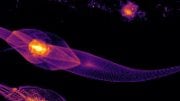




Another possibility, from a view of String Theory, is that Dark Matter appears to us as an effect of string/anti-string annihilations. As you may know, quantum mechanics requires that strings must be formed as pairs in the quantum foam – a string and an anti-string – that immediately annihilate each other. Quantum mechanics also requires both the string and anti-string to be surrounded by “jitters” that reduce their monstrous vibrating energies. What if this jitter remains for a fraction of an instant after their string/anti-string annihilations? This temporary jitter would be seen by us as matter, via E=mc2, for that instant before it too returns to the foam. That’s why we never see it – the “mass” lasts only for that instant but is repeated over and over and over, all over. Specifics on this can be found by searching YouTube for “Dark Matter – A String Theory Way”
Consider that light particles, being bosons, serve as their own anti-particles by virtue of embodying electric and magnetic vector field carriers that must reverse their orientation (rotate) as they propagate, an aspect of being effectively massless.
Suppose gravity is also carried by massless bosons and thus such carriers also must rotate their field vectors. Since light propagation involves sideward-pointing vectors rotating sideways (laterally), suppose the effects of gravity carriers must rotate orthogonally compared to light (longitudinally). This works out to multiplying the impact of Newton’s law, F(gravity)/G = (M1/d)x(M2/d), by a complex sinusoid. To agree with unbiased observations the sinusoid should have a wavelength on the galactic scale. This directly agrees with rescaling proton particle effect scale (approximately 10 to the minus 15th power in meters) by F(electrostatic)/F(gravity) between protons (approximately 10 to the 36th power, dimensionless), yielding a product of approximately 100k light years. Due to this carrier effect rotation, the inward component of the galactic gravity field may be obtained by multiplying Newton’s effect by a cosine function of distance, the lateral component is the product of Newton’s formula multiplied by a sine function of the distance. This is the basis for the concentric gap in placid ring galaxies such as Hoag’s object.
Take a look at M94, recently described as a “double ring galaxy” and compare it with Hoag’s object. The large ring of M94 has accumulated matter and energy from outside the galaxy to the point that angled inflows of the large ring’s entrained helically-circling matter into the central region have begun at two opposed points, creating a tilted central region edge artifact. As the rotation rate suggested above for gravity is considered to be definable by basic properties of nucleons it should be the same for all galaxies. Thus, as the outer ring of Hoag’s object is commonly believed to be around 120K light years, the size of M94 is here predicted to be within 5% of that figure.
As a progression of field vectors having a tail and a rotating head, it may be that photons have a practically 1-dimensional “shape” that resembles a string in terms of a propagating photonic field effect tail locus. As their own fundamental bosonic antiparticles, crossing photon field vectors cancel without self-annihilation by vector opposition at a single point. Gravitational information needs also to be extremely finely quantized in cross-section yet, in contrast to light, operable in a low energy regime. Same situation is likely the case for Planck-scale low net-energy gravitational field quanta, with the presumption that gravity and light quantize in fundamentally different ways.
Most approaches to DM use the so-called “virial theorem” that amazingly no one seems to want to put a person’s name to even though Newton/Einstein should get some credit for the implicit well-shape of the gravitational potential function, which is very closed-minded and gets leaned upon excessively by DM effect experts, just like the word “placeholder.”
It’s interesting that a string theory aficionado is able to relate dark matter effects to an effect resembling Hawking radiation initially associated with the intense gravitational fields around a black hole. “More black holes equals more dark matter effect” would be kind of hard to integrate with “clumpiness” factors, I imagine. BH experts are experts on entropy too, in theory. Anything to avoid fixing gravity and entanglement rules that claimed brains are too hot to carry entanglements long enough to matter. Apparently Russians have also been a huge help there.
Now waiting for an article on SciTechDaily from the royal gravity petty spite cartel on the latest background wave evidence showing the mass of supermassive “holes” is being greatly underestimated.